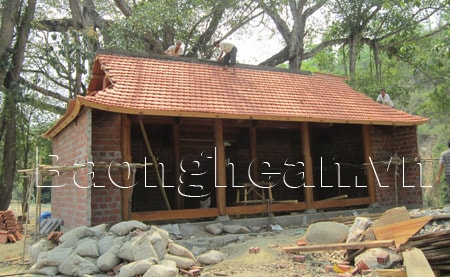Upgrading Duc Khanh Temple: Success from socialization
(Baonghean) -In early 2010, we had an article "The Legend of the Temple by the Nam Mo River" introducing the history of Duc Khanh Temple (commonly known as Cay Da Temple) in Canh village, Ta Ca commune (Ky Son). This is a place of religious and spiritual activities for the people of Canh village and Ta Ca commune in particular, and the whole Ky Son district in general. But at that time, the scale of the temple was still too modest and was hidden by the canopy and roots of ancient banyan trees, not worthy of the merit of the god worshiped by the people.
And the dream of the people at the source of Nam Mo is that the temple will be restored and upgraded in the near future. Now, the wooden temple with an area of 65 m2 is about to be completed, the long-standing wish has come true.

Duc Khanh Temple is being upgraded.
The history of the temple is closely linked to the story of Duc Khanh's founding and breaking of rocks. According to the elderly in Canh village, around the middle of the 17th century, this place was still wild, people still lived in tribes. One afternoon, an elderly couple and a child stopped under a banyan tree by the roadside. Then they helped the people eliminate wild animals, organized hunting trips to domesticate wild animals, mobilized human resources to level hills and mountains, and blocked streams to reclaim rice fields. Life became more and more prosperous and peaceful. That man was called Duc Khanh and was honored as "King of the village". He was originally a general under the command of a border chief. When the Northern invaders flooded the border area, Duc Khanh found a way with his wife to bring the chief's son to escape the enemy's pursuit. Arriving at Canh village, realizing that this place could be a long-term shelter, he decided to stop to recruit people to establish a village and create a new life. Duc Khanh regularly organized training and held martial arts competitions and hunting wild animals to train the militia. People from everywhere heard about it and came here to ask to live and work. Ban Canh was located on both banks of the Nam Mo River. Duc Khanh advocated helping people build boats and open markets to develop trade. Soon, this place was bustling with people on the wharf and under the boats.
Duc Khanh passed away at the age of 95. To commemorate his merits and pass them on to his descendants, the people contributed money and effort to build a temple. The temple was built under the shade of banyan trees where he once stopped and looked down at the Nam Mo River. Around the beginning of the 19th century, a huge flash flood devastated the Ta Ca area, turning the flat land into steep cliffs and rocky fields. The river wharf and market were moved to Phay village (today's Muong Xen town). Some time later, the people returned to reclaim Ta Ca, rebuild the village and did not forget to restore the temple to worship Duc Khanh.
In early 2011, the government and people of Ta Ca commune organized the Duc Khanh Temple Festival, attracting all the people in the region and tourists from near and far to attend. The commune People's Committee established a project to upgrade the temple using socialized funding to match its historical and cultural value. The estimated cost to upgrade Duc Khanh Temple is about 400 million VND, of which 230 million VND was mobilized from businesses, the remaining amount was contributed by the people. Up to now, the important items of the project are about to be completed and are expected to be inaugurated on the occasion of the festival at the end of the fourth lunar month.
Talking to us, Mr. Ho Sy Can, Deputy Secretary of the Party Committee of Ta Ca commune said: "In the near future, we will continue to develop a project to develop eco-tourism. Specifically, we will plant more ancient trees in the temple grounds to make it more sacred and ancient and restore the boat dock to both recreate the ancient landscape and serve the need to explore the beauty of Nam Mo Hydropower Reservoir. This will have the meaning of educating tradition and exploiting the potential to contribute to socio-economic development."
Cong Kien






